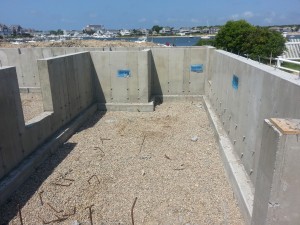By Erik Tolley
If you own a home or are considering buying  property on Cape Cod that is in a flood zone, remodeling and renovation projects can be complex. Flood proofing requires that the homeowner work with an experienced builder and licensed architect or engineer to assess the feasibility of the project.
property on Cape Cod that is in a flood zone, remodeling and renovation projects can be complex. Flood proofing requires that the homeowner work with an experienced builder and licensed architect or engineer to assess the feasibility of the project.
Homes located in flood hazard areas shown on Flood Insurance Rate Maps (FIRMs) are at higher risk of being damaged when flooding occurs. If your home is in the 1% annual chance floodplain (commonly referred to as the 100-year flood) it has a 26% chance of flooding over a 30 year period. View the map for your home at www.floodsmart.gov so you can make informed decisions about protecting your property, both financially and structurally.
Home improvement and renovation projects within flood hazard zones are subject to federal regulations which focus on limiting improvements or enlargement of existing structures that do not

Construction projects along the coast or in other areas with a high risk of flooding are subject to following FEMA’s regulations, including a flood proof foundation such as the one pictured here.
conform to the updated building codes. These regulations limit repair or improvement of existing structures to less than 50% of the assessed or depreciated appraised value of the home whereas when adding to a home that is in the flood plain any new construction, including small additions, must be entirely compliant. When renovating, or doing a combination of adding and remodeling/renovating, if the cost of the project as a whole exceeds 50% of the value (of the existing dwelling excluding land value), all existing components must be brought into compliance with the floodplain management standards. This can require elevation of the structure above the flood plain, as well as wind and seismic regulations. This often makes the demolition of the existing home and construction of a new, compliant dwelling the most financially feasible alternative and the better value. The intent is to limit liability for the Federal Government which subsidizes the National Flood Insurance Program.
New construction within a flood zone requires creating a foundation that has the ability to allow water to pass through, rather than building up hydrostatic pressure against outside walls, potentially leading to structural failure, and typically eliminates the ability to have a full basement. Velocity zones are areas subject to wave action, not just flooding, and have much more strict requirements; being built on pilings for example.
Some of the main components of complying with Flood Zone regulations for construction projects include:
- The lowest floor of residential structures must be elevated to 2 feet above the 100-year flood level. This includes new construction or substantial improvements (50% or greater of the assessed value) to any residential structure.
- Utilities must be designed and otherwise elevated or located so as to be resistant to flood damage.
- A drainage-control plan is required for all proposed development within a designated floodplain area.
- An Elevation certificate and Flood Proofing certificate along with other locally required permits must be obtained.
Whether you are looking to make renovations or build a new home in a flood zone an experienced builder and licensed architect or engineer will best be able to help you throughout the process.
About the Author: Erik R. Tolley, RA, LEED AP is the owner of ERT Architects, Inc. He has worked with clients through all phases of design and construction since 2001. For questions regarding construction in a flood zone or any other Cape Cod building projects he can be reached at 508.362.8883


